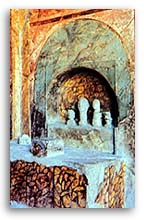 |
|
Over the centuries, the ancient Romans worshipped many gods and goddesses. Some gods had Roman origins, while others were borrowed and adapted from foreign cultures. People worshipped in public ceremonies as well as in their own homes. Let's look more closely at some of their religious practices. Official Religion
At first these gods and goddesses weren't represented with human bodies. But under the influence of the Greeks, the state gods took on human form. The Romans also adopted some of the Greek stories about their gods and how they related to each other, but the Roman deities always kept their Latin names. Special ceremonies and sacrifices were performed to satisfy the gods. |
|
Worship at Home Every house had a shrine, called a lararium, where the family worshipped daily. The gods and spirits that protected the home were honored at the shrine, along with the family ancestors (a lar is an ancestor's spirit.) These ceremonies usually involved pouring libations (liquids such as milk, oil, or wine) on a sacrificial fire placed on the altar. |
 Lararia for the House of Menander in Pompeii |
|
Foreign Gods Traditional Roman religion grew out of the needs of a simple agricultural society and evolved to serve the political needs of the state. As Rome grew and its urban society became more complex, people began to move toward religious beliefs that appealed to their individual spiritual needs. These needs were sometimes met by Eastern religious cults, which offered redemption for people through connection with divine powers. These foreign religions also offered a kind of equality among believers - slaves could be members as easily as the nobility. Two popular Eastern cults in Imperial Rome were the Cult of Isis and Christianity. |
 |
 |
 |
 |
 |
 |
 |
© Michael C. Carlos Museum of Emory University,
Memorial Art Gallery of the University of Rochester and Dallas Museum of Art
For more information please contact odyssey@emory.edu.
Last Update: